A brightly colored tropical plant featuring vivid shades of green, the Philodendron Lemon Lime will liven up any atmosphere. This stunning houseplant has beautiful large heart-shaped leaves wherever you position it, and it is easy to care for with little maintenance required.
The Philodendron Lemon Lime is one of the liveliest of the more than 500 Philodendron species in existence and a striking addition to any room or space.
Philodendron Lemon Lime Overview
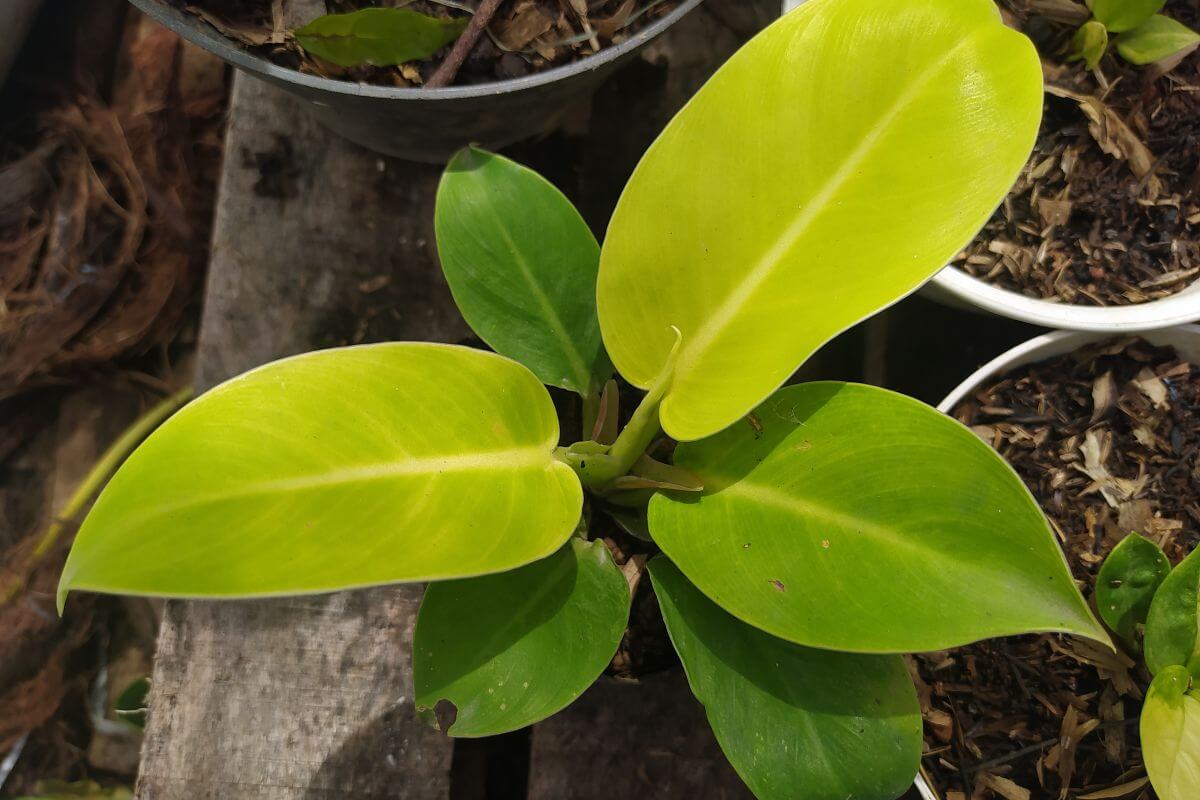
Known botanically as the Philodendron hederaceum Lemon Lime, like other Philodendron plants, it is a member of the Araceae family and has its origins in Central and South America. As a tropical rainforest species, it can be cultivated outdoors in USDA hardy zones 9 through 11.
Houseplant enthusiasts will enjoy the bright shades of green in the foliage that the Philodendron Lemon Lime produces. Cascading foliage in multiple shades that range from lime to a nice bright yellow will reward you year-round.
A climbing vining plant, the Lemon Lime produces bright lime green foliage with a hint of light brown and a pinkish tint. Leaves will average seven to eight inches in length, and stems will be about a foot long.
The Philodendron Lemon Lime rarely produces flowers, especially indoors, but when it does, they are pearl white in hue.
Philodendron Lemon Lime Care Guide
Like all philodendrons, the Philodendrum Lemon Lime requires very little care to thrive, but there are still things to keep in mind for a healthy plant.
Soil for the Philodendron Lemon Lime
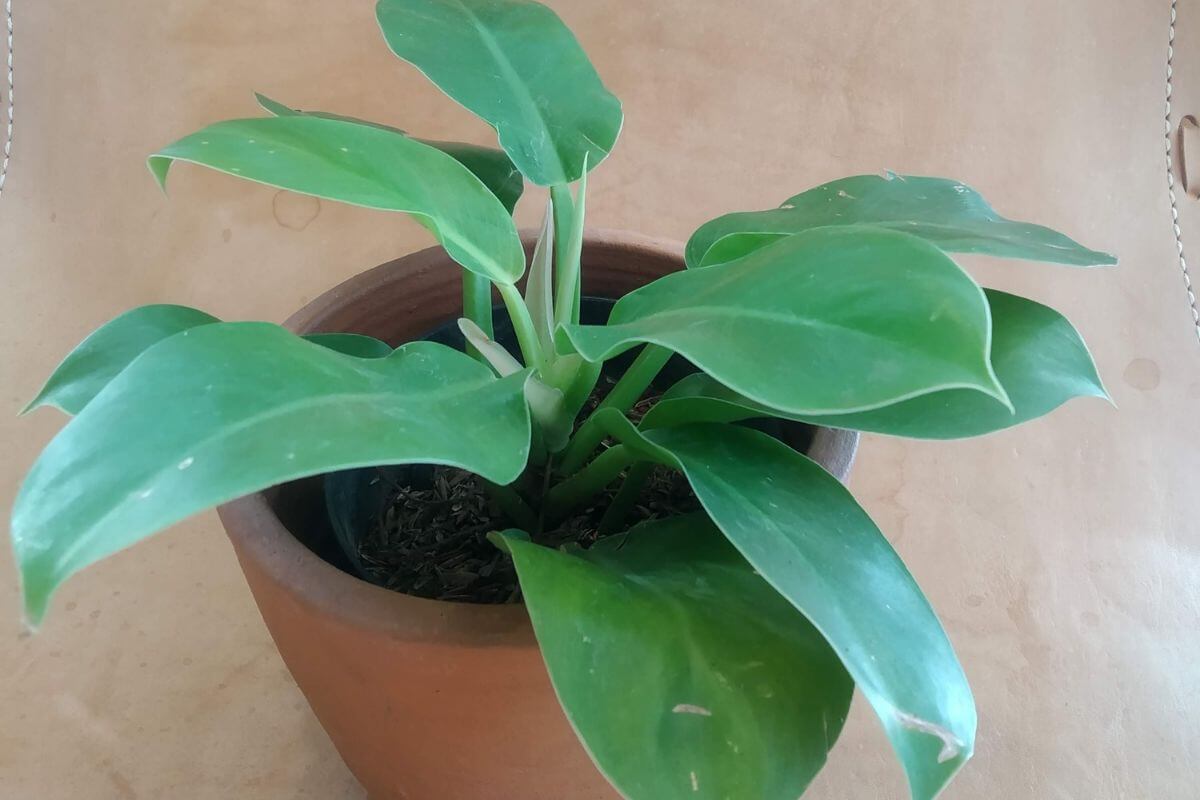
The Philodendron Lemon Lime is not fussy about soil as long as it is well-draining soil. It prefers a loose soil texture and the growing medium should be rich in organic matter for nutrition. A slightly acidic soil pH level from 6.0 to an alkaline soil of 8.0 will be good.
You can blend your own potting soil mix using:
- 3 parts quality potting mix
- 2 parts of cocopeat
- And a half dose of perlite to help the soil remain loose.
Light for the Philodendron Lemon Lime
If your home or office doesn’t offer much in the way of great light conditions, not to worry, as the Philodendron Lemon Lime can manage in the shade.
It will thrive more with good exposure to bright indirect sunlight, which will improve your plant’s expansion and its striking foliage.
This plant cannot endure direct light, as this will put foliage at risk of scorching, or leaves may turn an unhealthy yellow or brown. Your plant may also begin to wilt with too much direct sunlight.
The Lemon Lime is a durable plant and can grow well in low light, but growth will be slower. However, if the light is too low, leaves may droop as well.
Water and Humidity for the Philodendron Lemon Lime
Your Lemon Lime will require adequate water. Remember that it is found in tropical rainforests. This Philodendron will require watering weekly during its growing season. This can be reduced to monthly or to every other week in the winter months during the dormant period.
If the leaves turn brown, yellow, or soft, or begin wilting, the plant is most likely underwatered.
On the other hand, if the plant is overwatered, you’ll see yellow or brown leaves, leaves losing their vividness, and a mushy texture on the leaves.
Water your Philodendron when the top two inches of the soil bed are dry. Consider soaking your plant and leaving it in a sink to drain completely before returning it to its location. Do not leave the plant standing in a dish of water.
Although this is a tropical plant, average home humidity is usually adequate for its needs as an indoor plant. If leaves are larger, they may require a bit more humidity.
An ideal humidity level will measure from 40% to 60%. These plants are lovely when placed in steamy bathrooms, or you can opt for a room humidifier. Pebble trays and misting foliage are other options to increase humidity levels.
Another thing you can do is to spray the leaves with lukewarm water and wipe dust off them with a clean cloth. That will help prevent dust particles from clogging the leaf pores.
Temperature for the Philodendron Lemon Lime
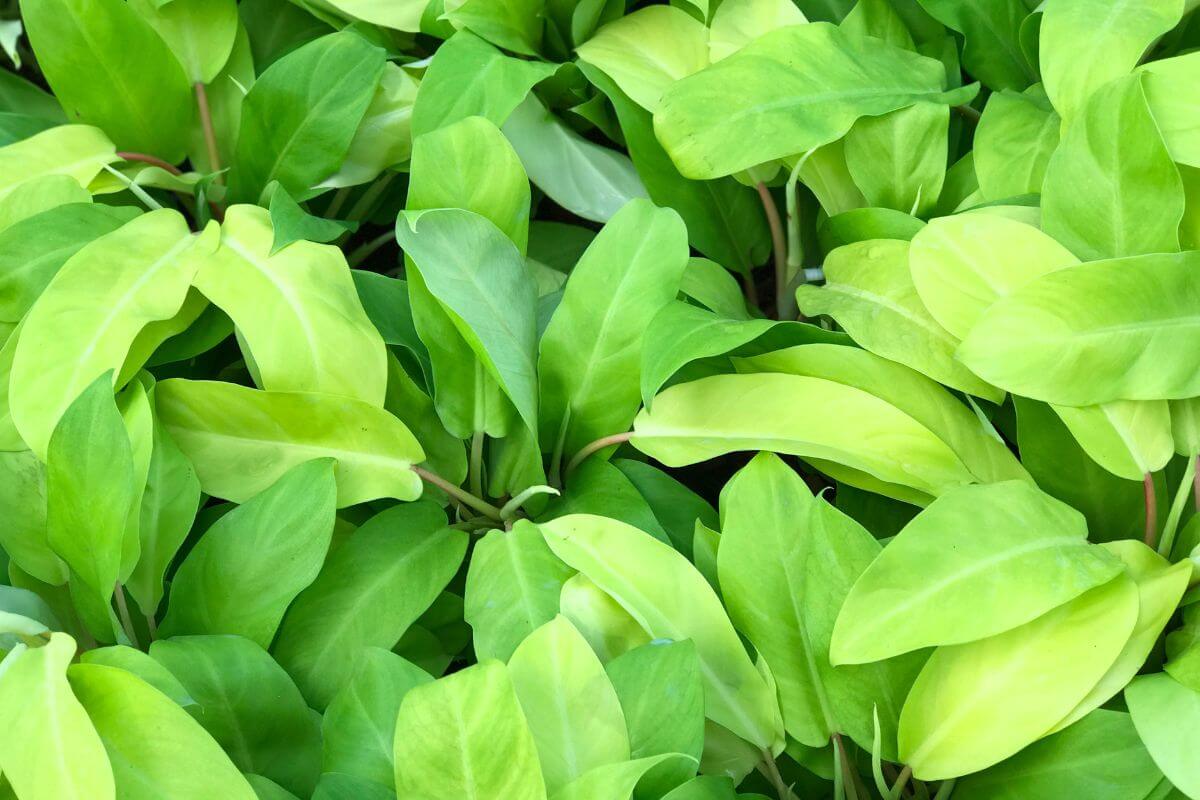
Temperatures during the daytime should measure between 60° and 75°F ideally. During the night, the environmental temperature should not drop below 55°F.
Generally speaking, a Philodendron Lemon Lime can manage temps that rise as high as 90° warmer and 45° cooler for very short periods of time. These extreme temperatures are not optimal for growth though and I would try to stay away from those temps.
Colder temperatures are more dangerous than warmer temperatures. If you observe that your plant is not producing new growth, the room is probably too chilly. The Lemon Lime also does not appreciate drafts, so keep it away from vents and heating or air conditioning units.
Fertilizer for the Philodendron Lemon Lime
During the growing season of spring and summer months, plants can be fertilized with a standard, balanced 20-20-20 houseplant liquid fertilizer diluted to half strength. A slow release fertilizer is another option for feeding.
Fertilize every other week or once a month during the growing season. In the winter, you can fertilize once every two months.
Be careful not to overfeed your plant as chemical fertilizers can cause salt buildup in soil and burn root systems. If you think you have over-fertilized because the soil bed turns a bit white, flush out your plant under a faucet and leave it to drain.
Pruning the Philodendron Lemon Lime
Before pruning, decide on the shape of the plant you want: bushy or trailing?
If you opt for a bushy plant, prune more often to maintain the shape. With trailing plants, you can prune once or twice a year. Always trim away dead, dying, or damaged leaves.
Use only sterilized gardening shears or scissors, never prune more than 50% of the plant at one time. Also, avoid pruning during the winter season when plants grow even more slowly.
Repotting the Philodendron Lemon Lime
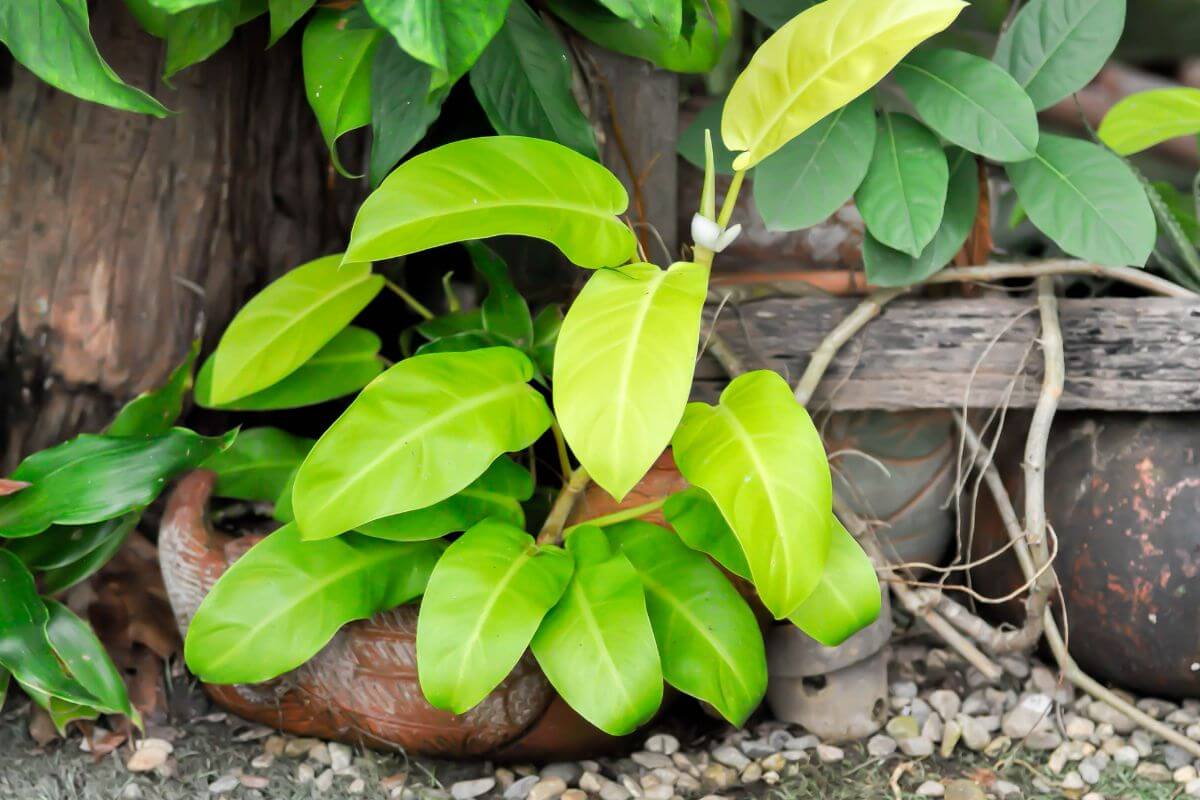
You will need to repot your Philodendron Lemon Lime every two years. A terracotta or clay pot is moisture-wicking, and that can help prevent root rot or fungal infections.
Plastic pots can contribute to those diseases due to excessive watering. Your pot should have sufficient drainage holes. Select a pot one to two inches larger than the root ball. When removing your plant, gently brush aside old soil and place it in a new pot with fresh, rich soil.
Propagating the Philodendron Lemon Lime
Spring and summer are the best times to propagate a Lemon Lime Philodendron. The easiest methods to propagate with stem cuttings in soil or water, or by using the air layering method.
Propagating with Stem Cuttings in Soil
- Trim a stem segment approximately four inches below a leaf node with sharp sterilized scissors. Leave at least two to four leaves on the stem if possible. Do not leave on the lower foliage near where you cut.
- Place the cut stem in moist soil. Before placing in a soil bed, dip the tip in rooting hormone.
- After planting, place it in a warm location with bright indirect sunlight.
- Roots should form within several weeks.
Propagating with Stem Cuttings in Water
- Trim a stem segment approximately four inches below a leaf node with sharp sterilized scissors. Leave at least two to four leaves on the stem. Do not leave the lower foliage on where you cut.
- Place the cut stem segment in a jar with water.
- Change the water weekly.
- Place in bright indirect light in a warm environment.
- Roots should form within several weeks. When roots grow to two to three inches long, your cutting can be transplanted into soil.
Propagating with Air Layering Method
Air Layering as a propagation method can only be used in the growing season.
- Trim a stem section with a node.
- Remove any extra foliage from the stem and slice into it.
- Place peat moss and soil around the wound and wrap it in plastic wrap. Close the ends of the plastic with ties to increase the humidity around the wound.
- When new roots emerge, you can remove the plastic and cut just below the stem cutting with new roots.
- Transplant the new cutting with roots into a container with potting soil.
Philodendron Lemon Lime Toxicity and Pets
According to ASPCA, the Philodendron Lemon Lime is toxic to cats and dogs because they contain calcium oxalate crystals.
Philodendrons can be toxic to humans as well, so it’s best to keep small children away from your plant. Keeping your plant out of their reach is the best idea.
Calcium oxalate crystals are not fatal but will cause swelling, burning, and difficulty breathing. The plant sap irritates the skin. If pets chew on the leaves and ingest large quantities, that can cause kidney failure.
Symptoms to watch for include:
- Your pet doesn’t have an appetite
- Swelling of the lips, mouth, and tongue
- Lesions in or around the mouth
- Vomiting
- Pawing at mouth
- Swallowing difficulty
- Excessive drooling
If a pet chews on the Philodendron Lemon Lime, rinse its mouth out. Wash your skin if there’s irritation. If there’s any swelling, contact your veterinarian. If severe symptoms appear, take your pet to an emergency care clinic.
Philodendron Lemon Lime Pests, Diseases, and Problems
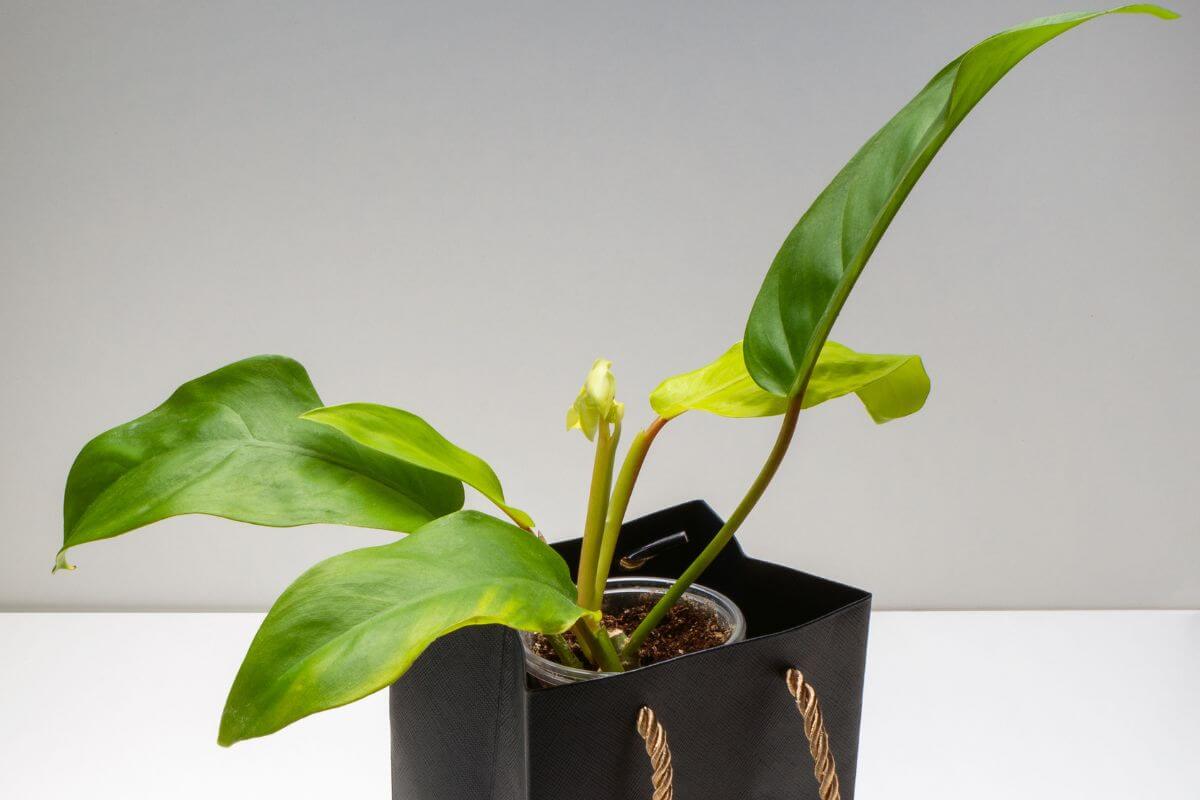
Pests
The most common pests to be on the lookout for are:
Mealybugs – These appear as white cottony deposits on stem joints and leaves. Take a cotton swab dipped in rubbing alcohol and manually remove them.
Spider mites – They appear as brown or yellow blotches on the upper leaves. Use insecticidal soap to help get rid of the spider mites.
Fungus gnats – These will not hurt your plant and live in damp soil near the soil bed surface. You can use an organic fungicide like neem oil to spray the plant to get rid of the fungus gnats.
Philodendron Lemon Lime Diseases
The largest risks to your Philodendron Lemon Lime are bacterial infections, root rot, and fungal infections. Overwatering is the most common reason for these illnesses. Excessive watering of soil or water on foliage can contribute to this.
Symptoms of these diseases include:
- Interruption of growth
- Stunted growth
- Wilting or drooping leaves
- Rotten leaves or rotting at the base of the stem
- Mushy texture of plant parts or roots
- Yellow or brown spots on leaves
- Small white spots on foliage
To treat your plant, remove all of the infected plant parts including, stems, leaves, and roots. Wash healthy roots and treat them with fungicide. Repot your Philodendron in fresh potting mix. Wait a week before watering anew.
Be sure to discard any diseased leaves, so they don’t affect other plants.
Final Thoughts on the Philodendron Lemon Lime
The Philodendron Lemon Lime is a lovely tropical plant that will brighten your home or office, adding a bit of spice to the décor. It’s easy to cultivate and asks very little of its plant parents. Its brilliantly bright colors will liven up your home year-round and you’ll be happy you have one.
Learn more about caring for other philodendron varieties with these care and grow guides:


